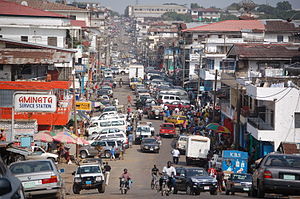It was only 12:13 PM in Monrovia and I could not afford to miss out on my lunch time that Friday, February 22, 2019 to be precise. I set out at a fast pace from my office to get lunch at a nearby food spot on Carey Street. As I walked by the stores lined up on Benson Street, between Buchanan and Center Streets, I encountered what seemed like an everlasting memory for a lot of folks who grew up in Central Monrovia: women and children gathered in circle by a water wank that supplies water to the residents of Benson Street’’.
If you are unaware, here is why they gathered around the truck: When the truck is done offloading to the buildings, the remaining water in the tank is rationed evenly between the people who live behind the buildings that the water was meant for, until it is finished.
For as long as I can remember, growing up as a kid in Monrovia on Snapper Hill, water shortage has been a major challenge for the inhabitants of Monrovia. If you have ever spent time with family or friends in Central Monrovia or even its surroundings, you would know that being rich or poor has nothing to do with your home, office or entertainment areas running out of water; even if water is available, there’s no guarantee it is safe – one has to chlorinate before use.
There are theories that state that the city of Monrovia was ultimately built for a little over 250,000 inhabitants, but due to internal migration, especially as a result our civil crises, the city has been overly populated with over a million residents, with more still continually migrating. I remember during the dark days right after the 2003 War, which led former President Charles G. Taylor to exile, the struggle for rehabilitation and reconstruction of the country knew no private citizen nor public servant, neither did it know the poor, the middle class, nor the wealthy. We all trekked to various communities which had access to wells and hand pumps in search of any kind of water first, then worried about it being clean and safe.
[Fun fact: the beautiful site of Cape Hotel located by the beach on the UN Drive, Mamba Point in Monrovia was once a pit storing fresh and clean water].
In 2003, I was a thirteen year-old boy. My siblings and I would leave the hills of Benson Street for Newport Street, Mamba Point and sometimes as far as the PHP Community behind the Army Barracks or Buzzy Quarter, in search of water. Nothing changed in this situation and for as long as I could remember, there was water shortage every dry season.
Liberia has two seasons, namely: Dry and Rainy Seasons. The Rainy Season starts anywhere between the second to third week of April and ends between the second to third week of October. After which we enjoy the Dry Season from October to March of the next year.
Now, you look at this little city and wonder what life is like for its inhabitants. A city well laid out with roads and blocks dividing and its historically named streets. It is said that the site of every beauty has a scar hidden somewhere and Monrovia, as a beautiful landscape, has her own, which is hazardous. The lack of sufficient or any water in this part of the country leaves a lot of people facing the fight against diseases and viruses known and unknown. The threats posed by the infestation of crawling insects and other flying bugs to our food, cooking/eating utensils and other essential items are unimaginable. Just thinking of these things, you get scared with the images you see when you use public bathrooms in the city whether in homes, offices or entertainment places. Sometimes, as embarrassed as an owner might be, he or she could tell you that the bathroom is out of use because something is broken.
Here are some of the ways residents attempt to manage water:
1. During the long periods of water shortage within the city, people will have to cook their food with small amount of water and reserve the waste water from dishes washing and house cleaning to flush down bathroom commodes.
2. Water is rationed for shower in homes and sometimes, showering is not as important for the kids or the unemployed, as it is to the dads, moms and employed folks, because these are the bread winners who go out there to interact with the world. So, everyone else will have to wait for when water is available. (If you were to conduct a survey, residents of Monrovia City use a lot of perfumes and colognes, the good ones too).
3. People drive out of the city, visiting friends and families, to fetch water from their wells and hand pumps.
Oh! In these situations the price of water usually becomes high. Between the years 2000 and 2010, a five gallon container of water could increase from $15.00 to $60.00 Liberian Dollars during the dry season.
This should give you an idea of how life is in Monrovia. As a curious kid, I would learn a lot from eavesdropping conversations kept between my parents and most people. Whenever the Liberia Water and Sewer Corporation (LWSC) Workers came to conduct surveys and do area mapping to help the water situation (in all fairness, I remembered they made several attempts) and rehabilitate its facility at the corners of Carey and Newport Streets, I would listen carefully about the progress. No solution ever was significantly effective when I was a kid. In today’s reality and carefully recording the dangerous 2014 Ebola crisis in Liberia, water was a major tool in combating the virus. In that instance and many others, water has been a saviour for our lives.
In conclusion, I am using this medium to bring attention to this serious issue and ask everyone to see the need to be advocates for the availability of safe water in their communities. Also, while we await the government’s own effort to do so, let’s also watch out for ourselves and family. We should also see the authorities responsible for these simple, but yet essential, rights of our people attempting to remedy the situation. People regularly die from common diseases that could be combated by simply washing hands with clean water and we should all fight to end those happenings.
Authored by Levi Hamilton Martin

